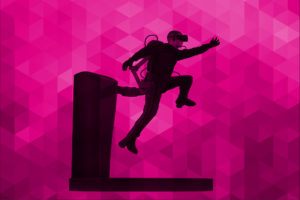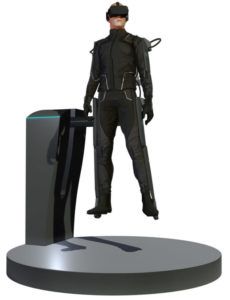Feeling Virtual Reality

AxonVR sets out to make Virtual Reality a truly immersive experience
Are you feeling me?
While Virtual Reality has been a discussed concept for over 20 years and has been picking up rapidly in the past few, it has, this far, been constraint to visual and sound immersion at best, leaving the experience interesting, but far from satisfactory. Even though strides have been made recently with products such as the HTV Vive allowing the player to move in space and be a part of the story, it is still limited, or at least was.
What is AxonVR?
 AxonVR is a uniquely innovative company creating one of the first solutions for VR haptics, allowing for virtual reality users to feel physical touch, and temperature, in order to create a considerably more realistic and immersive experience.
AxonVR is a uniquely innovative company creating one of the first solutions for VR haptics, allowing for virtual reality users to feel physical touch, and temperature, in order to create a considerably more realistic and immersive experience.
The company uses patent pending technologies developed in house to create HaptX, wearable “skin”, whether gloves or a full body suite, providing your body with feeling pixels, drawing from the object their shape, texture, temperature, and more[i]. Reading these attributes may sound somewhat dry, much like being immersed in a physical feeling less world it too partial. But what happens when you can actually feel..? This video may give you a notion:
https://www.youtube.com/watch?v=vYbt5tW3rHA
While the product has not yet launched commercially, it has been drawing considerable industry interest, including a $5.8 million[ii] in seed capital in December of 2016. Allowing the company to push forward to rolling out their groundbreaking product.
https://www.youtube.com/watch?v=wPDtXnE9crg
AxonVR creates a unique experience that can be implemented in several industries and applications to create value to potential customers. So where can it be used?
- Amusement Parks and Arcades – being uniquely placed to provide memorable experiences, the HaptX product can be an attraction of its own, providing visitors with an opportunity to go immerse themselves into a story (e.g. pet dragons from how to train a dragon, etc.).
- Video Games – Gaming taken to the next level with first person shooters becoming even more realistic and engaging. Gamers will now be able to get into character, and experience firsthand what their protagonist feels. (getting hit? Cold air when running? Etc.)
- Design and Manufacturing – these days, a lot of money is spent on building multiple actual prototypes in order to, beyond seeing the 3D model, feel the material and get the sense of the product. AxonVR will be able to reduce the number of prototypes required as it provides engineering teams and more to feel the product before any actual manufacturing is built[iii].
- Military Training – AxonVR can provide soldiers with a priceless training ground, allowing for training in all weather conditions, and limiting both the effects of irrelevant externalities as well as reduce cost of training, cancelling the requirement for physical ammo, etc.
Value Capture
As the product has not yet launched, AxonVR can currently look at several value capture paths:
- Selling Devices – the classic route of VR products is selling the device and letting customers use it at their will, this is, however, a path less feasible for a company targeting selling devices of this size.
- Subscription Model – in order to reduce the barrier of entry for new customers and allow them to receive a device without a large upfront payment, AxonVR may decide to “rent it out” and receive payment per usage.
Next Steps
As the technology is currently not fully developed and an MVP is almost ready to be commercialized, I would suggest the company go down a path of collaboration with design and manufacturing partners. The design and manufacturing requirements will be much less sensitive to performance such as the number of milliseconds delay (a.k.a swimming).
Going down the path of more relaxed technical requirements initially can provide the company with the opportunity to iterate further on the product’s quality and performance while achieving an initial revenue stream to help in financing the business.
[i] https://techcrunch.com/2017/01/23/axon-vr-promises-real-haptic-feedback-for-your-sojourns-into-virtual-reality/
[ii] https://www.crunchbase.com/organization/axonvr#/entity
[iii] http://www.geekwire.com/2016/25-year-old-just-raised-5-8m-startup-will-make-vr-experiences-indistinguishable-real-life/




Neat post Gil, thanks. The technology sounds neat and I would definitely be interested in trying it out, but I think it could have serious demand issues upon release. I can think of a couple of simple issues that I think would profoundly affect adoption. First, the hardware looks large and that it will take up a lot of space – who would want to put this in their home? I don’t pretend to know anything about fashion/interior design, but I don’t think this would be considered a good look for most. Second, in order to feel things properly, I would imagine the suit will need to hug the user quite tightly, which means most articles of clothing will need to be removed before putting on the suit. This will eat up a lot of time in a person’s day, especially when you can’t outsource putting a new suit on to anyone.
I do, however, think this could have military applications. Being able to feel an environment would be important.